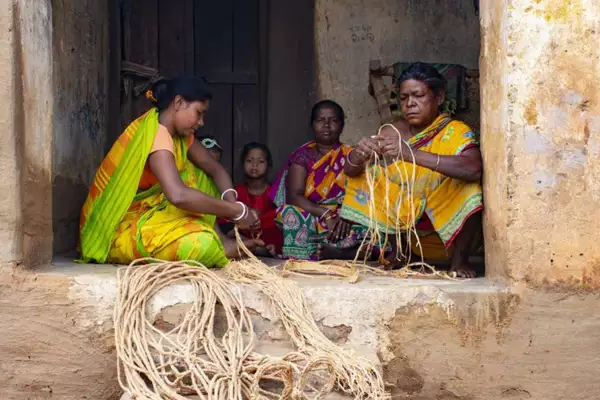The Mankidia Tribes in Odisha has recently been granted habitat rights over local forests under the Forest Rights Act (FRA), 2006, becoming the 6th Particularly Vulnerable Tribal Group (PVTG) in the state to receive this legal entitlement.
Mankidia Community’s Habitat Rights
- The Mankidia community, a PVTG, was formally granted habitat rights under the FRA.
- These rights allow the community to perform traditional and cultural activities without legal hindrance in their forest habitat.
- The recognition came through the district-level committee’s (DLC) approval, providing the community legal claim over their customary habitat in Mayurbhanj district.
Background on Forest Rights Act (FRA), 2006
- Aim: To recognize and secure the rights of indigenous and traditional forest-dwelling communities over forest land and resources.
- Enacted to recognize the rights of forest-dwelling communities over the land and resources.
- Provides individual and community rights over forest lands, including rights to protect and manage community forest resources (CFR).
- Section 3(1)(e) of FRA grants habitat rights for PVTGs and pre-agricultural communities.
Key Provisions of FRA:
- Ownership Rights: Communities can claim land ownership for cultivation and habitation, limited to up to 4 hectares.
- Minor Forest Produce: Rights to collect non-timber forest produce, including medicinal plants, fodder, and fuelwood.
- Forest and Biodiversity Management: Communities have the right to manage and protect forest resources, biodiversity, and cultural heritage.
- Protection Against Eviction: The Act safeguards communities from eviction from forest lands unless their rights are recognized.
- Role of Gram Sabha: The Gram Sabha is empowered under Article 243(b) to initiate the process of recognizing and vesting rights of tribal and forest-dependent communities.
- Forest as a State Subject: The Constitution of India lists ‘Forest’ under the State List, implying that states have the primary authority to regulate forests within their jurisdiction.
Significance of Habitat Rights under FRA
- Habitat rights ensure protection of cultural and traditional activities of PVTGs in forests.
- These rights cover both reserved and protected forests, securing the livelihood of forest-dependent communities.
- The habitat rights create a new governance model promoting indigenous knowledge and conservation of biodiversity.
FRA Implementation in Odisha
- Odisha leads in granting habitat rights under FRA, with six PVTGs having received approvals.
- First PVTG to receive habitat rights- Paudi Bhuyan in March 2024 in Deogarh district, covering 32 villages.
- Other PVTGs approved for habitat rights in Odisha-
- Juang (Keonjhar, Jajpur districts)
- Saora (Gajapati district)
- Chuktia Bhunjia (Nuapada district)
- Hill Khadia (Mayurbhanj district)
- Odisha is home to 13 PVTGs, the highest among all Indian states and Union Territories.
Comparison with Other States
- Chhattisgarh: Habitat rights granted to two PVTGs (Kamar and Baiga).
- Madhya Pradesh: Baiga community granted habitat rights.
- Maharashtra: Maria Gond community granted habitat rights.
About Mankidia Tribe
- Semi-nomadic Lifestyle: The Mankidia community is a semi-nomadic hunter-gatherer group.
- Location: Predominantly found in Odisha, particularly in districts like Mayurbhanj, Sambalpur, Kalahandi, and Sundergarh.
- Language: They speak a variant of the Mundari language, which is part of the Austro-Asiatic language group.
Origin:
- They are an ethnic offshoot of the Birhor tribe.
- Their name is derived from their skill in catching monkeys (Mankada in Odia).
Livelihood:
- Known for making ropes using fibers found in Similipal forests.
- They rely on small animals and forest resources for survival.
- Primarily food gatherers, their livelihood depends on forests.
Housing:
- They live in temporary makeshift settlements called tandia.
- Their dome-shaped leaf huts are known as Kumbhas.
Ref: Source
| UPSC IAS Preparation Resources | |
| Current Affairs Analysis | Topperspedia |
| GS Shots | Simply Explained |
| Daily Flash Cards | Daily Quiz |
Frequently Asked Question:
What rights were recently granted to the Mankidia tribe?
The Mankidia tribe was granted habitat rights under the Forest Rights Act 2006, allowing them legal access to their traditional forest habitat.
What is the significance of the Forest Rights Act for tribal communities?
The Forest Rights Act recognizes individual and community rights over forest lands, protecting the livelihoods of forest-dwelling communities.
How does the Mankidia tribe sustain its livelihood?
The Mankidia tribe, known for rope-making and trapping small animals, relies on forest resources for sustenance.
What are habitat rights under the Forest Rights Act, 2006?
Habitat rights allow forest communities to perform traditional and cultural activities without legal hindrance in their customary habitats.



